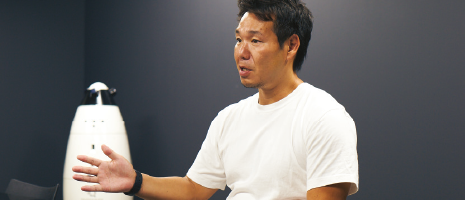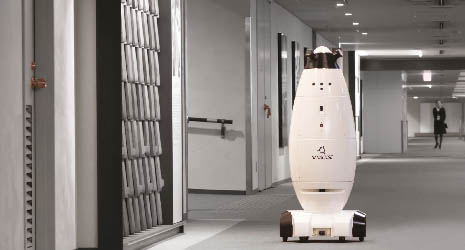Home > Highlighting JAPAN > Highlighting Japan December 2018 > Science & Technology
Highlighting JAPAN


Robots on Patrol
Robots capable of operating on their own and creating a 3D map of their surroundings in real time—including the presence of obstacles and people—will soon be patrolling office buildings and shopping centers as the first line of security. The developers of the SQ-2 security robot provide a description of the powers of their prototype, and potential uses for robots to come.
Developed by SEQSENSE Inc., the SQ-2 is a new security robot capable of autonomous operation that constructs a 3D map of its surroundings in real time. It doesn’t need GPS to find its way; the SQ-2 comes equipped with three laser scanners for 3D mapping and maneuvers while marking its own location and identifying any obstacles or changes to the environment. The SQ-2 can also detect when there are people nearby, so it can patrol and guard safely even in populated areas.
SEQSENSE is a startup founded with the goal of identifying real-world uses for the autonomous robot technology Professor Yoji Kuroda developed at Meiji University’s School of Science and Technology. The first market they are targeting for their autonomous robots is the security industry. With one SQ-2 able to patrol for twenty-four hours, for example, companies can slash the cost of hiring human security personnel as well as the expense of training and recruiting them.
“Right now the security industry is seriously short-handed. It’s also hard for one security professional to check multiple cameras placed throughout a facility, and it’s expensive to hire more guards,” states SEQSENSE CEO Soichiro Nakamura when asked to explain the reasons behind the advent of security robots. “If we leave the work of actual patrolling to security robots, humans can handle the sort of high-level security tasks that only people can perform.”
What the firm’s engineers struggled with the most during the R&D phase was a thorough analysis of security tasks. Those tasks include the surveillance and management of the facility and its equipment, reporting suspicious individuals, and countless other duties carried out behind the scenes. While occasionally reassessing how the tasks would be carried out and how the security robot would be used, they developed the SQ-2 from scratch, consulting with security companies and building management companies along the way.
The resulting robot has a simple design that won’t seem startling even when moving through crowds of people in office buildings and shopping centers. In addition to its three laser scanners, the SQ-2 boasts a 360-degree camera and a high-resolution camera, along with a number of sensors such as a heat sensor and ultrasonic wave sensor. It also has a microphone and speakers for communicating with control centers. In the future, that array of features will be augmented with options such as a sensor for detecting gas and other odors and a vital signs scanner.
In addition to the SQ-2’s autonomous robotics technology, the firm’s engineers designed the built-in software and circuitry, devised a cloud computing system, and programmed an AI that can perform facial recognition and other tasks. “This was not an academic exercise,” says Nakamura. “Our team members are all engineers who want to make robots the world will find useful. They wanted to take on the challenge and carve out their own place in the market.”
The company plans to release SQ-2 in summer 2019, and is busy developing new versions based on continuous real-world testing. And security robots are just the first wave; autonomous robots have strong prospects in a variety of fields, including manufacturing, shipping, construction and farming.
A future in which humans and robots work even more closely together is almost at hand. With an eye toward that era, the engineers at SEQSENSE are working not to just to create robots but to build a new society.
© 2009 Cabinet Office, Government of Japan







